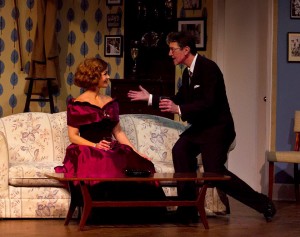Dial M for Murder: Dialing A for show Murder

Dial M for Murder
By Frederick Knott
Ottawa Little Theatre
Director: Margaret Harvey O’Kelly
When amateur theatre becomes amateurish, even a carefully constructed play suffers under the strain. Sadly, this is precisely what happens with Ottawa Little Theatre’s production of Frederick Knott’s 1952 drama Dial M for Murder.
Among the clues that this thriller is unlikely to thrill are the numerous lighting miscues that frequently draw laughter from the audience, awkward pauses and embarrassing silences that are the result of one of the actors forgetting his lines and the slow set changes. Further clues that the production is not working are a lack of apparent chemistry between the heroine and her erstwhile lover and the declamatory style of the villain of the piece.
All this is particularly depressing in the light of the obvious effort that is behind ensuring the accuracy of the period costuming by Gillian Siddiqui and the set design by Robin Riddihough.
More of a will-he-get-away-with-it than a traditional whodunit, Knott’s script is probably best remembered as the 1954 movie starring Grace Kelly and Ray Milland. And more than 60 years later, it can still work on stage as a recent production by the Perth Classic Theatre Festival demonstrated.
Because the early section of the script is so heavy on exposition, the play is likely to be somewhat creaky in the early stages almost regardless of the quality of direction and performance, but more rounded characterizations would help with pacing and maintaining the audience’s interest. When the play, rather than the seeming discomfort of the ensemble, comes to the fore, the OLT production, as directed by Margaret Harvey O’Kelly, is a little more effective.
As the psychopathic focal point of the drama, Sean C. Dwyer does add a light layer of menace to the character of former tennis pro Tony Wendice, and appropriately insincere concern for his wife, Margot. However, quiet menace would be more effective than shouting. As Margot, his intended murder victim, Heather Archibald is clear about her character’s motivation and elegant in her movements, but is no more convincing in her continuing attraction to her former lover, mystery writer Max Halliday (Frank Sasin) than he seems to her. However, Sasin is smooth in his delivery and is likely to have delivered a better performance with stronger direction.
As with many murder mysteries of the period, it is up to the police detective to solve the crime and, as Inspector Hubbard, Tony Adams offers a tip of the hat to the disheveled TV Detective Columbo in a reasonable presentation that becomes bogged down in dry moments when he loses his lines.
While definitely not one of OLT’s finest hours, Dial M for Murder is still worthy of note as a detailed jigsaw.
The OLT production of Dial M for Murder continues to November 5.
Director………………………………………………………………….Margaret Harvey O’Kelly
Set……………………………………………………………………….Robin Riddihough
Costumes…………………………………………………..……………Gillian Siddiqui
Lighting…………………………………………………………………..Brian Cano
Sound…………………………………………………………………….Bradford MacKinlay
Cast
Margot Wendice…………………………………………………………..Heather Archibald
Max Halliday………………………………………………………………Frank Sasin
Tony Wendice……………………………………………………………..Sean C. Dwyer
Captain Lesgate…………………………………………………………….Kevin Anderson
Inspector Hubbard………………………………………………………….Tony Adams
Thompson/Williams………………………………………………………….Amanuel Abebe/Samuel T. Corley